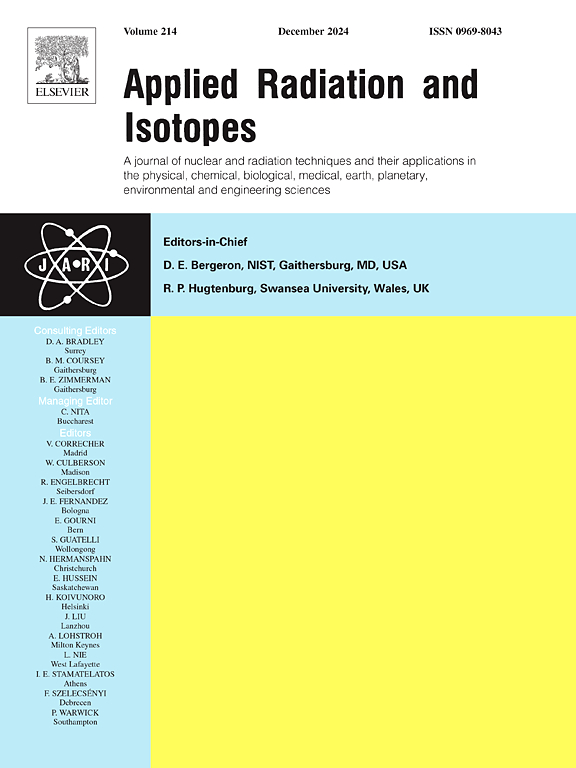验证 252Cf(s.f.) 中子场中的俘获反应截面。
IF 1.6
3区 工程技术
Q3 CHEMISTRY, INORGANIC & NUCLEAR
引用次数: 0
摘要
我们对以下俘获反应进行了研究:197Au(n,g)198Au、63Cu(n,g)64Cu、45Sc(n,g)46Sc、181Ta(n,g)182Ta、140Ce(n,g)141Ce、139La(n,g)140La、176Yb(n,g)177Yb、55Mn(n,g)56Mn 和 141Pr(n,g)142Pr。实验得出的反应速率与在 MCNP6.2 传输代码中使用最先进库 IRDFF-II、ENDF/B-VIII.0、JENDL-5 和 JEFF-3.3 进行的计算结果进行了比较。实验的重点是高能中子范围内的俘获反应。为了抑制散射的低能中子,所有活化材料都被一个直径为 30 厘米的球形镉表面所包围。实验得出的 197Au(n,g)198Au、63Cu(n,g)64Cu 反应速率与使用所有最先进的核数据库进行的计算结果一致。在评估 139La(n,g)140La和 55Mn(n,g)56Mn反应时,发现所有库的数据差异最大。除了 45Sc(n,g)46Sc反应之外,应用 JENDL-5 库数据的实验反应速率与其他反应的结果非常吻合。181Ta(n,g)182Ta反应速率与使用任何资料库得出的结果在不确定范围内都不一致。176Yb(n,g)177Yb 反应速率只有在使用 JENDL-5 和 ENDF/B-VIII.0 库进行计算时才会比较一致,而不像 JEFF-3.3 库。使用 JEFF-3.3 和 ENDF/B-VIII.0 库计算的 140Ce(n,g)141Ce 和 141Pr(n,g)142Pr 反应速率在不确定范围内不一致。本文章由计算机程序翻译,如有差异,请以英文原文为准。
Validation of capture reactions cross sections in 252Cf(s.f.) neutron field
We have investigated following capture reactions: 197Au(n,g)198Au, 63Cu(n,g)64Cu, 45Sc(n,g)46Sc, 181Ta(n,g)182Ta, 140Ce(n,g)141Ce, 139La(n,g)140La, 176Yb(n,g)177Yb, 55Mn(n,g)56Mn, and 141Pr(n,g)142Pr in a standard 252Cf(s.f.) neutron field. The experimentally derived reaction rates were compared with calculations using state-of-the-art libraries IRDFF-II, ENDF/B-VIII.0, JENDL-5 and JEFF-3.3 performed in MCNP6.2 transport code. The experiment was focused on capture reactions in high energy neutron range. To suppress scattered low energy neutrons, all activation materials were enclosed by a spherical cadmium surface of 30 cm in diameter. Experimentally derived reaction rates of 197Au(n,g)198Au, 63Cu(n,g)64Cu reactions agree with calculations using all state-of-the-art nuclear data libraries. The highest discrepancies were found when evaluating 139La(n,g)140La and 55Mn(n,g)56Mn reactions utilizing all libraries. Experimental reaction rates applying data from the JENDL-5 library agree very well with the results of other reactions except for the 45Sc(n,g)46Sc reaction. 181Ta(n,g)182Ta reaction rate does not agree within uncertainties using any library. The 176Yb(n,g)177Yb reaction rate agrees reasonably well only when performing calculation using JENDL-5 and ENDF/B-VIII.0 libraries, unlike JEFF-3.3 library. 140Ce(n,g)141Ce and 141Pr(n,g)142Pr reaction rates applying JEFF-3.3 and ENDF/B-VIII.0 libraries do not agree within uncertainties.
求助全文
通过发布文献求助,成功后即可免费获取论文全文。
去求助
来源期刊

Applied Radiation and Isotopes
工程技术-核科学技术
CiteScore
3.00
自引率
12.50%
发文量
406
审稿时长
13.5 months
期刊介绍:
Applied Radiation and Isotopes provides a high quality medium for the publication of substantial, original and scientific and technological papers on the development and peaceful application of nuclear, radiation and radionuclide techniques in chemistry, physics, biochemistry, biology, medicine, security, engineering and in the earth, planetary and environmental sciences, all including dosimetry. Nuclear techniques are defined in the broadest sense and both experimental and theoretical papers are welcome. They include the development and use of α- and β-particles, X-rays and γ-rays, neutrons and other nuclear particles and radiations from all sources, including radionuclides, synchrotron sources, cyclotrons and reactors and from the natural environment.
The journal aims to publish papers with significance to an international audience, containing substantial novelty and scientific impact. The Editors reserve the rights to reject, with or without external review, papers that do not meet these criteria.
Papers dealing with radiation processing, i.e., where radiation is used to bring about a biological, chemical or physical change in a material, should be directed to our sister journal Radiation Physics and Chemistry.
 求助内容:
求助内容: 应助结果提醒方式:
应助结果提醒方式:


